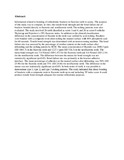| dc.contributor.author | Ng'ang'a, Peter M | |
| dc.contributor.author | Øgaard, Bjørn | |
| dc.contributor.author | Cruz, Roberval | |
| dc.contributor.author | Chindia, Mark L | |
| dc.contributor.author | Aasrum, Ella | |
| dc.date.accessioned | 2013-06-25T05:51:25Z | |
| dc.date.available | 2013-06-25T05:51:25Z | |
| dc.date.issued | 1992-09 | |
| dc.identifier.citation | American Journal of Orthodontics and Dentofacial Orthopedics Volume 102, Issue 3, September 1992, Pages 244–250 | en |
| dc.identifier.uri | http://www.sciencedirect.com/science/article/pii/S0889540605810595 | |
| dc.identifier.uri | http://erepository.uonbi.ac.ke:8080/xmlui/handle/123456789/39307 | |
| dc.description.abstract | Information related to bonding of orthodontic brackets to fluorotic teeth is scanty. The purpose of this study was to compare, in vitro, the tensile bond strength and the bond failure site of brackets bonded directly to fluorotic and nonfluorotic teeth. The etching patterns were also evaluated. The study involved 26 teeth classified as score 3 and 4, and 26 as score 0 with the Thylstrup and Fejerskov's (TF) fluorosis index. In addition to the clinical classification, difference in the concentration of fluoride in the teeth was verified by acid etching. Brackets were bonded with a composite resin after etching the enamel surface with 40% phosphoric acid for 60 seconds. Tensile bond strength was determined with an instron testing machine. The bond failure site was assessed by the percentage of residue cement on the tooth surface after debonding and the etching pattern by SEM. The mean concentration of fluoride was 2888.5 ppm (SD 1081.7) in the fluorotic teeth and 1227.1 ppm (SD 526.3) in the nonfluorotic teeth. The mean bond strength was 7.8 N/mm2 (SD 1.47) for the fluorotic teeth and 8.6 N/mm2 (SD 2.19) for the nonfluorotic teeth. The difference between the means for bond strength was not statistically significant (p>0.05). Bond failure site was primarily at the bracket-adhesive interface. The mean percentage of adhesive on the enamel surface after debonding was 70% (SD 25.90) for the fluorotic teeth and 75% (SD 24.66) for nonfluorotic teeth. The difference in the means was not statistically significant (p>0.05). In both series of teeth, it was possible to demonstrate type 1, type 2, and type 3 etching patterns. The study indicated that direct bonding of brackets with a composite resin to fluorotic teeth up to and including TF index score 4 could produce tensile bond strength adequate for routine orthodontic purposes. | en |
| dc.language.iso | en | en |
| dc.publisher | University of Nairobi | en |
| dc.title | Tensile strength of orthodontic brackets bonded directly to fluorotic and nonfluorotic teeth: An in vitro comparative study | en |
| dc.type | Article | en |
| local.publisher | Faculty of Dental Sciences, University of Nairobi | en |

